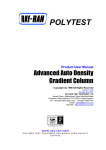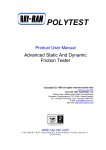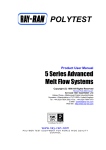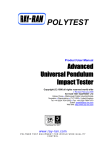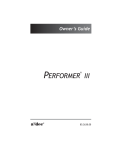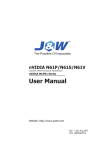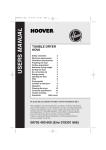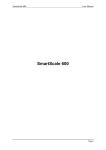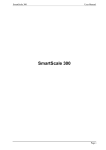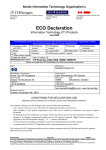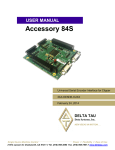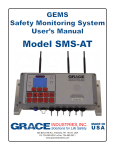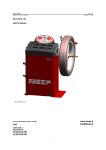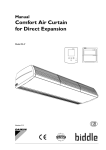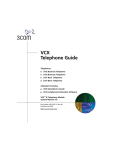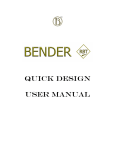Download POLYTEST - Ray-Ran Test Equipment LTD
Transcript
POLYTEST Model 2 Test Sample Injection Moulding Apparatus Copyright (C) 1998 all rights reserved world wide • Revised Sept 2004 issue 2 RAY-RAN TEST EQUIPMENT LTD Kelsey Close • Attleborough Fields Industrial Estate Nuneaton • Warwickshire • CV11 6RS • United Kingdom Tel: +44 (0)24 7634 2002 • Fax: +44 (0)24 7664 1670 E-Mail: [email protected] Web Site: http://www.ray-ran.com www.ray-ran.com POLYMER TEST EQUIPMENT FOR WORLD WIDE QUALITY CONTROL 1 Model 2 Test Sample Injection Moulding Apparatus CONTENTS Quick Reference Guide................................................................... 3 User Manual..................................................................................... 4 Description of the Machine ............................................................ 4 Caution During The Operation Of The Machine ........................... 4 Lifting & Installation........................................................................ 4 Electrical Power Supply ................................................................. 5 Tool Block........................................................................................ 5 Basic Tool Block Moulding Parameters........................................ 5 Special Tool Blocks ........................................................................ 5 Before Using & Storing The Machine............................................ 6 Compressed Air Supply ................................................................. 6 Tool Heater (Where Fitted) ............................................................. 6 Loading The Polymer...................................................................... 6 Operation Of The Machine ............................................................. 6 Changing The Piston & Cylinder Liner ......................................... 7 Temperature Control....................................................................... 8 Weights & Dimensions ................................................................... 8 Ram Assembly Diagram ................................................................. 9 Ray-Ran Products & Services...................................................... 10 2 Quick Reference Guide Model 2 Test Sample Injection Moulding Apparatus Basic Moulding Technique As with any moulding machine, moulding parameters have to be established to suit the particular material characteristics and the section and size of the shape being moulded. Most materials and shapes are very different. In our experience we have found that the following guidelines are a useful starting point. Barrel Temperature Generally, set the barrel temperature high and reduce as necessary, especially if the polymer burns or degrades. Tool Temperature For most polymers a tool temperatures of up to 60 °C is sufficient. Increase the tool temperature if the polymer freezes quickly. Material Quality Normally, fill the cylinder to the top. Using the piston and air control, compress the material to decrease the bulk and then refill the cylinder. The polymer will melt more efficiently. The tool block must be pushed back during this operation to avoid polymer freezing in the gate. Time For Material To Melt As a general rule, the material will slowly fall from the die orifice when fully plasticised. With the tool block pushed to the back, purge out a small amount of polymer then using the spatula knife provided, trim the excess material from the nozzle and quickly pull the tool block forward and inject. IMPORTANT The special cam locking mechanism on the tool block MUST be locked before injecting. If it is not, the material will flash between the plates and it will be impossible to unlock the tool. In the event of this happening, the tool block will have to be removed from the machine and disassembled. Under no circumstances should the special cam locking mechanism or tool plates be forced as damage will occur to the insert faces. Air Pressure Most polymers, when fully molten, will inject between 70 - 120 PSI. Some stiffer materials will require a greater pressure. As a general rule, start at around 70 PSI and increase accordingly. Continuous Moulding Every time a sample is moulded, re-charge the barrel, filling to the top. With the tool block pushed back, compress the sample using the piston and air to reduce the bulk. Before every injection, purge slightly to atmosphere and cut off the surplus polymer before pulling the tool block back to the front position and quickly injecting. Special Larger Tool Block And Larger Tool Inserts With larger surface areas, it is advantageous to lubricate the surfaces of the plates with a mould release agent. User Manual 3 Model 2 Test Sample Injection Moulding Apparatus Please read this manual before attempting to operate the machine. All the information necessary to successfully produce test samples has been included in this manual, and if used correctly the Test Sample Injection Moulding Apparatus will provide you with an effective and trouble free system that will serve you for many years. However, if after reading this manual you have any questions concerning the instructions or recommendations regarding the use of the machine please contact RayRan for assistance. Description Of The Machine The Ray-Ran Model 2 Test Sample Injection Moulding Apparatus has been specifically designed to produce a very wide variety of laboratory test samples such as colour plaques, tensile and impact test pieces. Polymer is loaded into the top of the liner which is heated to the required temperature to plasticise the polymer. The piston is then pressed down into the top of the liner and extrudes the polymer through the nozzle / orifice and into the tool sample insert. After the polymer has been allowed to set for a few seconds, the tool block cam is released and the tool sample insert and top plate withdrawn. The moulded test sample is removed, the orifice is cleaned of residual polymer, and the tool sample insert together with the top plate are replaced and clamped in the tool block ready for the next sample to be moulded. Caution During The Operation Of The Machine A heater band is fitted around the outside of the cylinder and, if specified, a cartridge heater unit is fitted inside the tool block. Although measures have been taken to avoid direct contact with the heater units, caution must still be taken when operating the machine as inevitably surrounding areas will heat up during the operation of the machine. It is recommended that protective gloves should be used when filling, replacing or cleaning the cylinder liner, withdrawing the tool sample insert and removing the moulded test sample. The machine should be allowed to cool down before any maintenance or adjustments are carried out. Lifting & Installation The machine can be easily lifted by two people, each holding an upright support column and the base of the machine. If using lifting equipment, place a lifting sling under the top cross member taking care that the air hoses are well clear of the sling.The machine must be firmly bolted through the holes provided in the base of the machine to a robust bench or stand. The Pneumatic Ram will require fitting to the apparatus if, when unpacked, it is detached from the unit. This is for packing convenience and the following fitting instructions should be followed. (See assembly diagram page 9) • Remove the 4 off M12 nuts from the fixing screws located in the top plate Ram mounting holes. • Pull the Ram arm into the down position and remove the piston support boss and locking nut from the thread. • Place the Ram onto the top mounting plate and ensure the pipe connectors are facing the connecting pipes and lever valve. Align the Ram with the top plate fixing holes and tighten the bolts into the Ram with a 19mm A/F spanner. • Connect the pipes to the Ram ensuring the longer pipe is fitted to the TOP air connector and the shorter pipe to the BOTTOM air connector. • Screw the locking nut onto the thread to its uppermost position and then fit the piston support boss. Now tighten the locking nut down onto the Piston Support boss. 4 Model 2 Test Sample Injection Moulding Apparatus Electrical Power Supply The machine can be supplied in two versions as follows. 220-240 volts @ 50 Hz 110 volts @ 60 Hz Please check the machine label to confirm the voltage. The machine power supply connection socket incorporates an integral 10 amp fuse. The mains power supply plug must be earthed and fitted with a 13 amp fuse. Tool Block If the machine has been supplied with the standard tool block it will accept inserts of:- Length Width Thickness * 184 mm 44.45 mm 12.7 mm Pease note these are not Maximum Moulding dimensions. * The tool sample insert must be positioned under the top plate and is locked in position by the bottom plate being forced upwards by a unique cam device activated by turning the tool block handle in a clockwise direction. A variety of different tool sample inserts may be used but it is most important that the thickness of 12.7 mm is always maintained. I.e. For a blank sample of say 4 mm, the blank or mating plate must be 8.7 mm thickness. Basic Tool Block Moulding Parameters The basic tool block has been designed to accommodate most test samples required by all International Standards. E.g. BS, ASTM, DIN, ISO, JIS, etc. The system incorporates exchangeable inserts for each sample thus allowing low cost tooling. * The following maximum dimensions for moulding Length Width Thickness * 180 mm 38 mm 12.7 mm The basic tool block incorporates a unique cam locking system. Special Tool Blocks Any size or type of tool can be supplied with the following maximum machine parameters. 5 Model 2 Test Sample Injection Moulding Apparatus Length Width Thickness 200 mm 200 mm 25 mm The above are maximum physical dimensions. The maximum size in volume of the sample is governed by the maximum volume capacity of the cylinder. Before Using & Storing The Machine For protection during storage and transit the working parts of the machine have been treated with an anti-rust solution. Please ensure that the machine surfaces are cleaned before use. If the machine is not going to be used regularly, ensure that the cylinder liner bore, nozzle and the tool block components are protected from deterioration. Compressed Air Supply The maximum operating pressure MUST NOT exceed 150 PSI (10.3 bars). It is important that an inline air filter / regulator should be fitted to the air supply before it is connected to the machine. The machine is supplied with its own secondary filter, regulator and pressure gauge. Tool Heater (Where Fitted) The tool block temperature required varies with the type of polymer being moulded, but generally it will be much lower than the temperature setting required to plasticise the polymer in the liner. Determining the ideal temperature for a given polymer can only be obtained by experiment. It is recommended to start with a low temperature setting and gradually increase the temperature until the ideal moulding conditions are obtained. Loading The Polymer Load the polymer into the bore using the filling hopper provided with the machine. Transfer the polymer into the top of the cylinder bore pushing down on the handle. Periodically during the polymer filling process, lower the piston to compress the polymer so that a full charge can be put into the cylinder. Operation of the Machine This machine has been specifically designed to produce a wide variety of test samples such as colour plaques, tensile and impact test samples. To produce such samples it has been found that the digital tool heating package is required to obtain the best results. The standard cam operated tool block has been designed to accept inserts for numerous different test sample forms such as tensile bars, HDT bars, impact bars, colour plaques, etc. For optimum performance an air supply of about 80-120 PSI is required. When the air supply is connected to the machine the pneumatic cylinder ram is automatically pushed back to its fully returned position, and in doing so, compresses the nozzle locking springs positioned immediately below the pneumatic cylinder. With the nozzle locking springs compressed, the nozzle is lifted clear of the tool block which is then free to be moved forward into the moulding position and backwards to the unloading position. 6 Model 2 Test Sample Injection Moulding Apparatus If the air supply is turned off ensure that the tool block is first in the unloading position. Set the tool block and cylinder liner to the required temperatures and allow both to stabilise. It may be necessary to adjust the temperature setting in order to determine the optimum settings for each polymer. With a little experience, it becomes obvious whether the temperatures need to be raised or lowered for each station. In almost every case the tool block temperature will need to be set a little lower than the cylinder temperature. It is recommended that the temperatures are set a little lower than expected and then gradually increase the temperature until the ideal conditions are obtained. Position the tool block in the unloading position (pushed back). Position the mould insert and mating top plate into the tool block and turn the locking handle to lock up the tool block. This is achieved by a cam lock device (high mechanical advantage) connected to the locking / release handle, and therefore hand tightening is sufficient. Important - if the tool block is not locked up when moulding the polymer will be forced into the spaces around the mould insert. It will then be extremely difficult to release the tool block, and it may prove necessary to dismantle the complete tool block in order to free the tool insert. If the tool block cannot be released with hand pressure remove the top plate. DO NOT hammer or lever the release handle. Load the polymer into the top of the cylinder liner and leave to plasticise. If a full charge of polymer is required, lower the piston (see below) a few times just to compress the polymer down into the cylinder liner. This should only be a momentary load onto the polymer. As soon as the polymer has plasticised, cut off any polymer which has already passed through the nozzle and pull the tool block forward into the moulding position. Operate the control valve which will direct compressed air into the top of the pneumatic cylinder. As soon as the ram starts to come down the nozzle locking springs will be released and force the nozzle into the tool block forming a sealed connection before the polymer is injected. As the ram continues to come down, the piston will enter the cylinder liner, compress the polymer and inject it into the mould insert in the tool block. Wait a few seconds for the polymer to set and then release the control valve which will automatically raise the ram and compress the nozzle locking springs, lifting the nozzle clear of the tool block so that it can now be pushed back. Turn the release handle to unlock the tool block so that it can now be pushed back. Turn the release handle to unlock the tool block, and withdraw the mould insert and top plate. Press by hand the test sample out of the mould insert. Ensure that any residual polymer around the orifice on the top plate of the tool block is removed so that the polymer has free access into the mould insert. The mould insert and top plate can be returned to the tool block and another test sample produced. When you have finished moulding, always purge out any remaining polymer and clean the components. Changing The Piston & Cylinder Liner Often there is a need to quickly change from one polymer to another or use another colour. This machine enables both the piston and the cylinder liner to be changed in just a few seconds. By having a spare cylinder liners and nozzles, one set can be used whilst cleaning the other at your leisure. To remove the piston turn it anti-clockwise and pull down. By lowering the piston down, it can be removed. Having done this the cylinder liner can also be removed. The cylinder liner and polymer loading funnel are secured to the main cylinder with a fork locator to facilitate easy removal of the cylinder liner without the need to have to contact the hot components. Screw the fork handle into the fork locator and withdraw it. Place the fork locator into the holes immediately above the ones it has just been taken out of. The fork locator now passes through the upper part of the polymer loading funnel and cylinder liner. This assembly can now be lifted up clear of the main cylinder and removed from the machine. 7 Model 2 Test Sample Injection Moulding Apparatus Reverse the above procedure to replace both the cylinder liner and piston. Temperature Control The temperature controller for the cylinder heater band and the tool block heater cartridge (where fitted) is a self tuning West N6100 instrument. The operating parameters of each instrument have been factory set and should not require any further adjustment. For information, a manual of the temperature controller is supplied with the machine. After turning on the machine, the “SET” temperature which is the temperature you wish to operate the machine at, appears in the lower of the two digital displays. To adjust the “SET” temperature press the lower “Ú” key pad to reduce the “SET” temperature and the raise “Ù” key pad to increase the “SET” temperature. Once the “SET” temperature has been selected the temperature controller will then automatically adjust, monitor and stabilise the temperature of the cylinder liner and tool block to the “SET” temperatures. Weights & Dimensions Net Weight Gross Weight Gross Width Gross Depth Gross Height Cylinder Bore Diameter Cylinder Length 55 kg 107 kg 60 cm 38 cm 126 cm 19.02 mm 180 mm 8 9 Ray-Ran Products & Services Raw Material Evaluation Code RR/5MBA RR/5SA RR/5MPCA RR/DGA RR/BDA RR/ADV RR/VOY RR/DIS RR/MB Product Model 5MBA Melt Flow Indexer Model 5SA Melt Flow Indexer Model 5MPCA Melt Flow Indexer 3 Column Density Gradient Apparatus Apparent Bulk Density Apparatus Adventurer Balance (Readability 0.1mg) 110/260g Capacity Voyager Balance (Readability 0.1mg) 62/410/100g Capacity Discovery Balance (Readability 0.1mg) 110/310g Capacity Moisture Balance (Readability 0.1%, 0.05%, 0.01%) 110/35/45g Cap Sample Preparation Code RR/TSMP2 RR/HCP RR/PCP RR/NC RR/CNC RR/CNC 2 TSC + Standard Product Model 2 Test Sample Injection Moulding Apparatus Hand Operated Test Sample Cutting Press Pneumatically Operated Test Sample Cutting Press Auto Cycle Test sample Notching Cutter Test Sample Profile Cutter Test Sample Profile Cutter - Larger Test Sample Cutters Sample Testing Code RR/HDV2 RR/HDV4 RR/HDV6 RR/TAA RR/LTB RR/ESC RR/FSL RR/FSHP RR/IMT RR/FWT RR/FD RR/ETT RR/FT RR/M D202 B202 WS777 Product 2 Station HDT/Vicat Softening Point Apparatus 4 Station HDT/Vicat Softening Point Apparatus 6 Station HDT/Vicat Softening Point Apparatus Thermal Ageing Apparatus Low Temperature Brittleness Tester Environmental Stress Cracking Apparatus Unrestrained Linear Thermal Film Shrinkage Apparatus Hot Plate Film Shrinkage Apparatus Universal Pendulum Impact Tester Falling Weight Impact Tester Falling Dart Impact Tester Advanced Elmendorf Tear Tester Static And Dynamic Friction Tester Universal Tensile Tester – Various Capacity Digital Handheld Durometer Analogue Handheld Durometer Analogue & Digital Durometer Workstations 10











